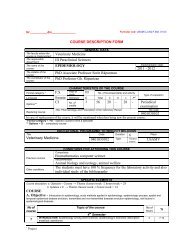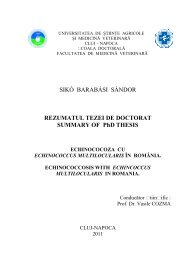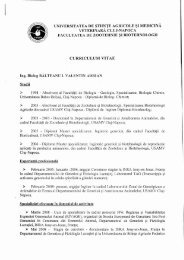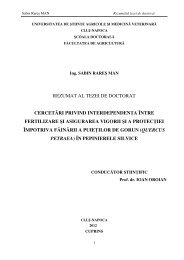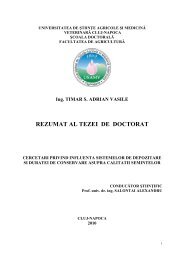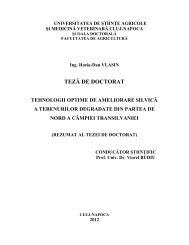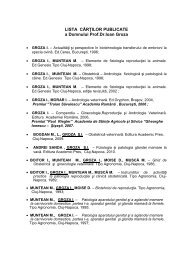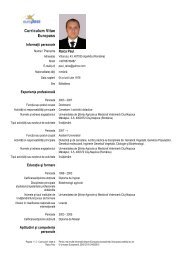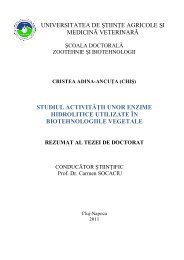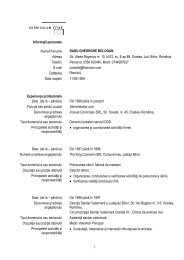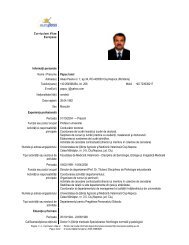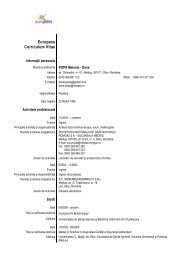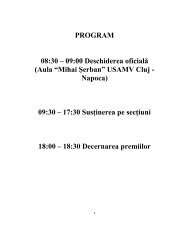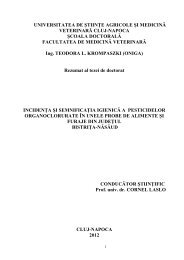Rezumat Romana Melinda Tofalvi - USAMV Cluj-Napoca
Rezumat Romana Melinda Tofalvi - USAMV Cluj-Napoca
Rezumat Romana Melinda Tofalvi - USAMV Cluj-Napoca
You also want an ePaper? Increase the reach of your titles
YUMPU automatically turns print PDFs into web optimized ePapers that Google loves.
4.3. FEEDING INFLUENCE ON BEE COLONIES DEVELOPMENT AND<br />
HEALTH<br />
Worker bee coming out of the cell as an insect is incompletely developed. It will<br />
have to consume pollen during six-nine days in order to complete growing and to develop<br />
the glandular system. By feeding, the body weight and total nitrogen content is<br />
increasing. Young worker bees lack of pollen will only live a short period of time and are<br />
not capable of royal jelly secretion. Worker bee, that becomes a harvesting bee has more<br />
diminished needs of nitrogen food and will consume more honey or nectar, giving up<br />
pollen.<br />
Not every sort of pollen has the same alimentary value to bees. There are good and<br />
bad sorts of pollen with different composition especially regarding protein content. So far<br />
the alimentary needs of the colony are not known and even the best artificial diets were<br />
not able to substitute the pollen during long periods.<br />
Has to be noticed the fact that there are some plants, few in our flora, which have<br />
toxic pollen for honeybees in large amounts. It has to be also noticed that honeybees do<br />
not harvest pollen more or less dangerous for themselves except when there is a lack of<br />
food. Honeybee is very different from other animals, it selects very precise the food. By<br />
studying these selections we will be able to know better the alimentary needs of the<br />
colonies.<br />
4.4. THE USE OF SUGAR SYRUP IN SUPPLIMENTARY FEEDING OF BEES<br />
The most efficient stimulative feeding is the administration of 800-1000 ml syrup<br />
1:1 weekly for each colony, method that ensures the increasing of brood with 19.5%.<br />
Daily administration of smaller doses of syrup (100-200ml) was proved to be less<br />
effective, because the brood quantity only increases with 13%, even though uncapping<br />
1dm 2 of honey comb every 2-3 days gives good results, the method is not applicable in<br />
practice due to frequent interventions and also especially to stilling.<br />
Sugar syrup 1:1 is made as follows: in an enamel pot a certain water quantity is<br />
being boiled. During boiling an equal amount of sugar is added and is being mixed<br />
continuously with a wood spoon until all the sugar is dissolved.<br />
A special attention requires the caramelization of the syrup, which makes it<br />
unhealthy for honeybees. The formed foam has to be removed (Hristea, 1976;<br />
Mărghitaş, 2002, 2005).<br />
4.5. PROTOFIL<br />
Protofil is treatment product destined to treat Nosema, to stimulate honeybee<br />
colonies, which is developed by Research-Development Institute for beekeeping<br />
Bucharest. It is an exclusive plant extract.<br />
It is a brown liquid, transparent, with characteristic smell and taste. It is delivered<br />
in plastic bottles of 1 kg and 500 grams. The bottles have to be kept in dark, dry spaces,<br />
at room temperature.<br />
With the help of active constituents from plants, vitamins and microelements, that<br />
Protofil contains, it stimulates the digestive enzymatic secretion of honeybees and larvae,<br />
leading to a high level of food digestibility. It inhibits intestinal pathogen flora and stops<br />
in a great measure the evolution cycle of Nosema apis. Helps queens to increase laying<br />
eggs and increases the population.<br />
42



